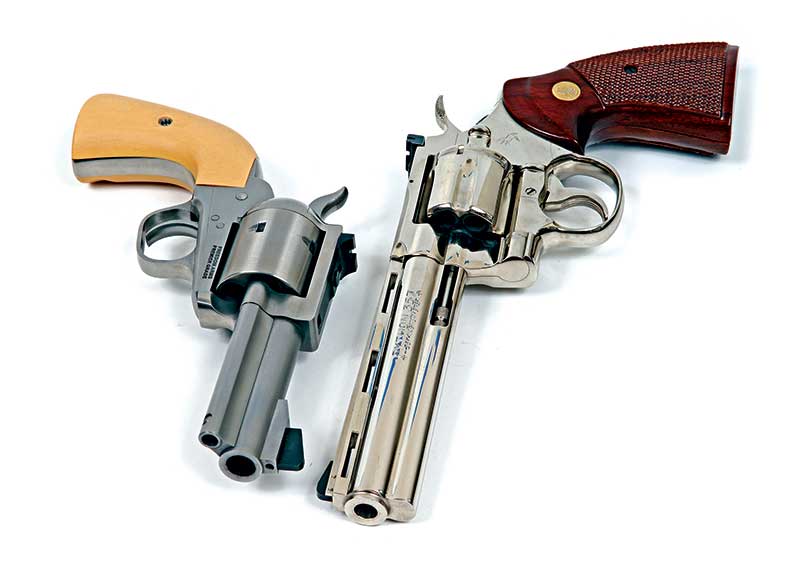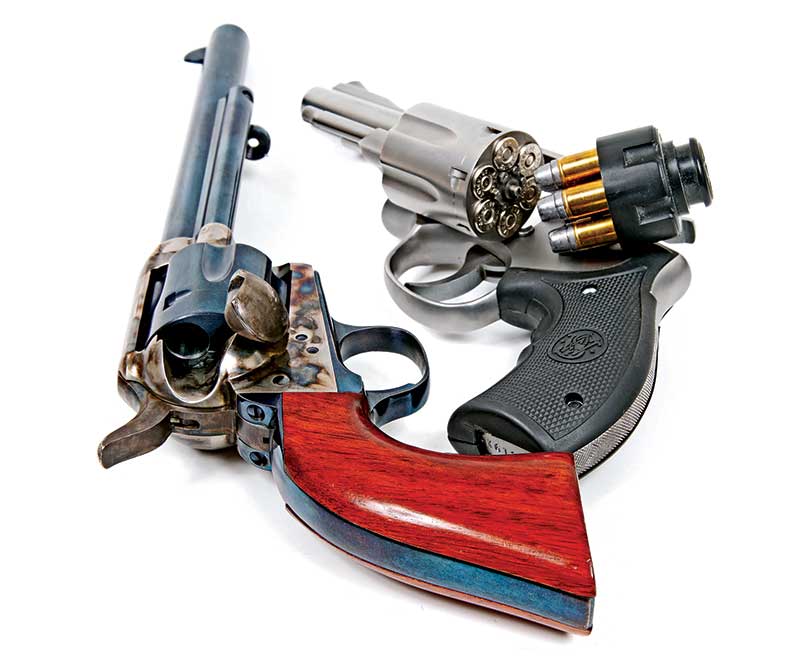DOUBLE OR SINGLE ACTION?
A Revolver Conundrum
I’m pleased to make note of a heart-warming trend among younger shooters. It seems while many young people begin life as Polymer-shooters, what happens next is what’s interesting. Many of these new shooters realize it’s a lot harder to shoot a real gun than it is to shoot a video game gun, it’s more expensive — and there’s actual work involved. You need to pay for a gun, buy ammo and accessories, find a range, learn to shoot, obey rules and a host of other “non-fun” things — at least non-fun to them. “Hey, this isn’t what I thought it would be.” And they’re right.
But what happens next is what’s encouraging. The “Gee, I don’t like this after all” crowd sells their guns (or stops renting them …) and moves back to playing video games. But a segment understands the challenges of learning to shoot, the responsiblities of gun ownership and the good friends easily made among shooters can be awfully appealing. They then tend to do two things.
First, they become sponge-like and reach out anywhere they can to find more about their new found interests. And, much to my delight, one of the things they often do is subscribe to American Handgunner and write me e-mails asking very good questions. What’s even more agreeable is the fact they discover — wait for it — revolvers. No, really. And so begins their start on the satisfying journey toward becoming well-rounded shooters. Their first e-mail to me usually goes something like this:
“Um, my name’s Kevin and I was at the range the other day and this guy next to me, he was sorta’ older, but he was real nice, and, um, anyway, he had a revolver and offered me a chance to shoot it. He showed me how to open the, uh, cylinder, and eject the empty cases, then load it again. He also explained how it can be single action or double action, which I now understand finally! I was amazed how accurate it was, and I hit the target better than I do with my (fill in the blank here) semi-auto. Then he brought out a Ruger Blackhawk, another revolver, but this one needed to be cocked each time so I think it was single action. I liked it too, and it reminded me of a cowboy gun. Now I want to buy a revolver, but I don’t know if I want one like the S&W with the cylinder that opened, or the Ruger Blackhawk. Can you help me out?”
Of course we can, Kevin.
You’ll find learning to shoot revolvers is like opening a giant door to a new world. You’ll discover you just doubled the potential you have for enjoying your shooting even more, and you’ve also just cracked the history book on handguns at the same time. As you already realized a quality revolver can be astoundingly accurate and most have a reliability factor most semi-autos can only dream about. Pull the trigger and they go bang unless there’s something wrong with the ammo — and if there is, just pull the trigger again and you’re still in the fight.
But should you buy a single action or double action first? Let’s talk about what they do, then you decide.
A single-action (SA) revolver does one thing when you press the trigger — it fires the gun. You need to “cock” the hammer to enable the trigger to trip the sear (dropping the hammer) which hits the firing pin, firing the cartridge.
On a double action (DA) the trigger press can do two things: cock the hammer (as you press it back) and then trip the sear, firing the gun as you keep pressing. So it does “two” things when you press — the trigger movement cocks the hammer and fires the gun in one stroke. You can also manually cock the hammer, then when you press the trigger (a much lighter trigger pull weight) it only does one thing — fires the gun — hence that’s single action. So a DA can also be fired SA, but an SA revolver can only be fired single action. Get it?
So, what does it all matter? For self-defense, a DA revolver is most appropriate. There are no safeties to fuss with and you don’t need to cock the hammer to make it work. Just aim and press the trigger. The DA trigger pull cocks the hammer, advances the cylinder and trips the sear, firing the gun. With training, a good revolver shooter can shoot as accurately in DA mode as he can in SA mode. No fooling.
Also, ergonomics are different for DA revolvers, they “feel” different from single actions and their “grips” are shaped like a “plow” handle (according to shooter’s jargon. Also, a huge advantage DA revolvers have over SA revolvers is the fact you can load or eject all 6 (or 7 or 8 or 10!) rounds at once from the cylinder, and load them all at once using a “speed” loader of some kind. Single action revolvers require you to open the loading gate and eject each empty, one at a time using the ejector rod.
If you’re buying a revolver just for fun, say plinking, target shooting, hunting or just to look at because they’re pretty, it doesn’t matter whether you buy a DA or an SA revolver — or “Sixgun” as our own John Taffin calls any of ’em, regardless of capacity. Don’t let anyone tell you DA revolvers are more accurate than SA revolvers either. A high-quality SA revolver will shoot as well or better as any high quality DA revolver.
The lesson here is if you’re buying a revolver for defensive use, the double action (think: S&W, Taurus or Ruger DA revolvers, for instance) makes the most sense. Also, if you want a big-bore revolver for protection against dangerous animals, I’d go with a DA revolver so you don’t need to fuss with fumbling with cocking a hammer while you’re being eaten by a bear.
But like many guns, most SA revolvers benefit from a good action job as many of their factory triggers are gritty and often have heavy pull weights. Most DA revolvers have very light weight, pretty much creep-free SA trigger pulls, but longer, sometimes gritty DA pulls.
In in all honesty, you’ll want both. I’d recommend something like a Ruger (or other maker’s) single action .22 of one form or another to get your feet wet. My first revolver was a Super Single Six Ruger in 1968. I still have it and shoot it and still enjoy it every time. Then, follow up with a DA revolver of some kind, likely in .357 Magnum (so you can usually shoot .38 Specials!) but play with .357 Magnums now and again for fun. That really opens the door further and I promise you’ll soon be re-reading your Handgunner magazines looking for articles on “Big-Bore Blasters” and “Reloading for the .45 Colt” and other topics you might have just glossed over before.
And, just so you know, it’s already too late for you if you’ve read this far. You’re doomed. Just buy your first revolver — and stop wondering what it’d be like to own one! It’ll be great fun.







